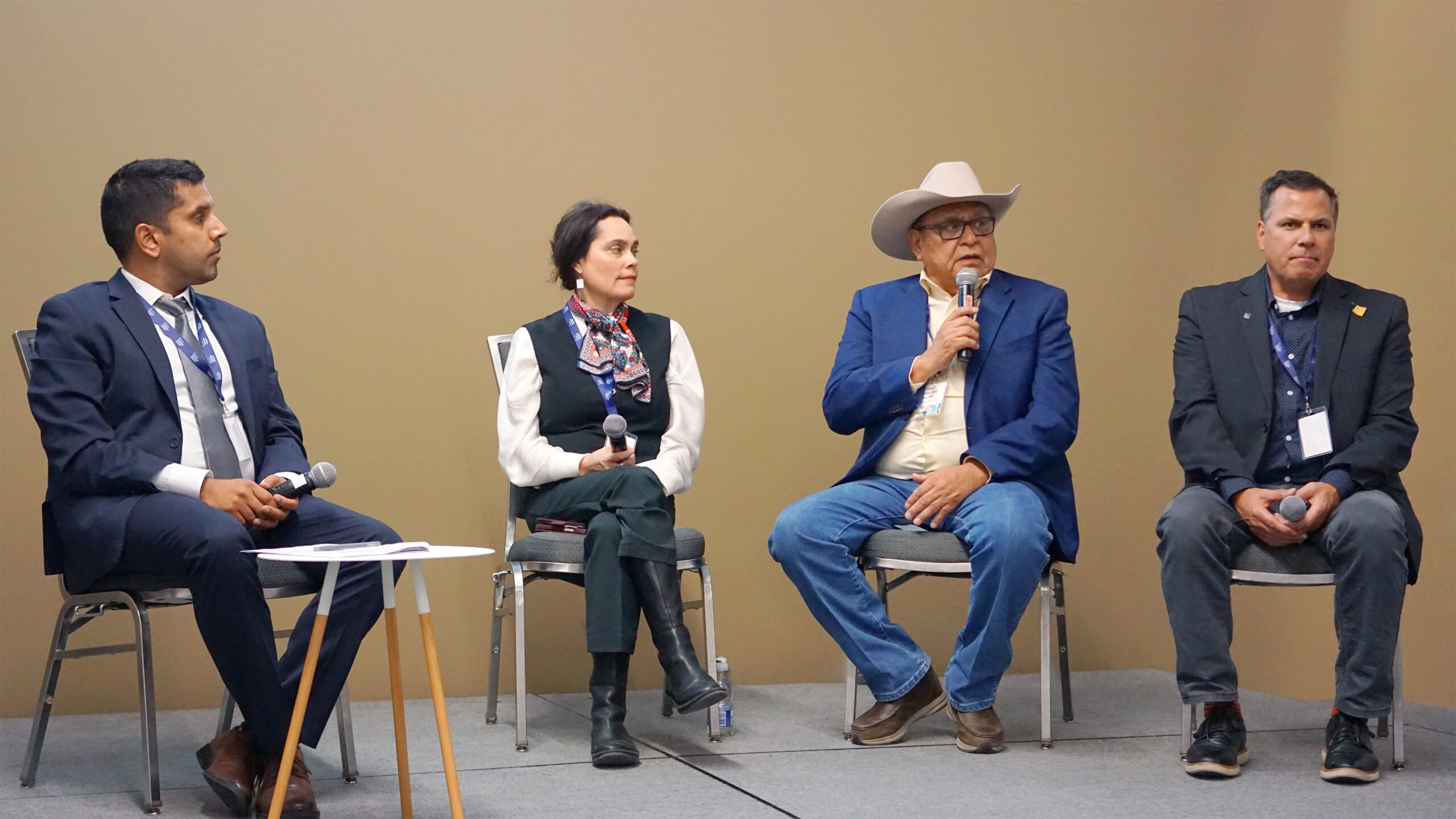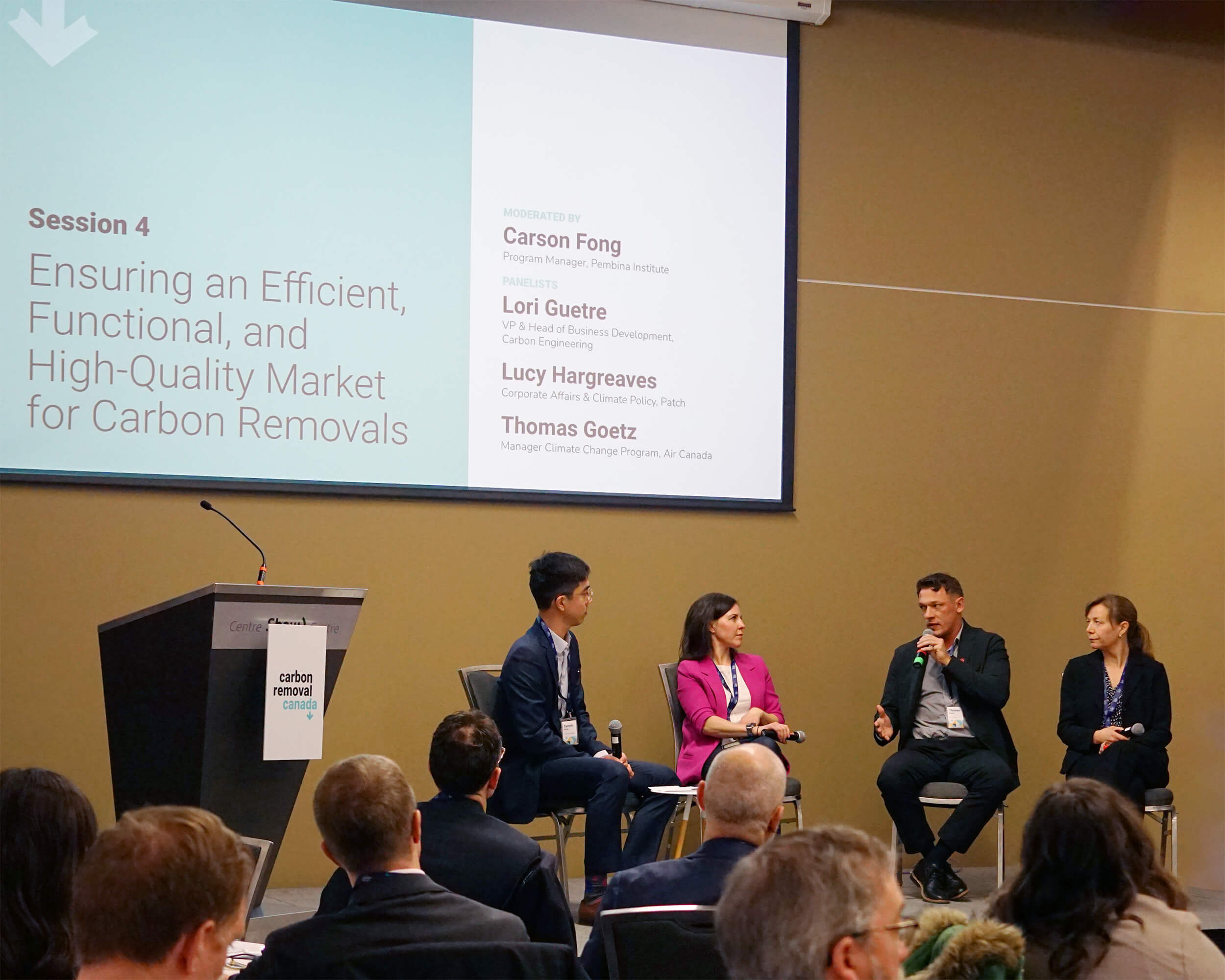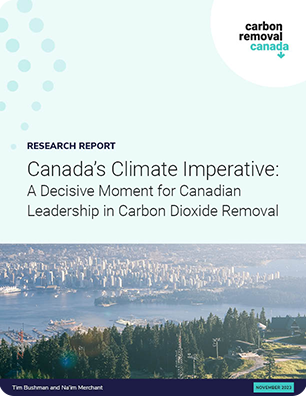The objective was simple: bring together the carbon removal sector, its stakeholders, and government officials, put them in a room for the day and create space for discussions that can lead to meaningful change. It sounds straightforward, but establishing Canada’s inaugural Carbon Removal Day marked a critical step in our journey toward a net-zero future. This event brought together people from all walks of life dedicated to grappling with the big questions surrounding carbon removal. Together, amongst many things, we delved into strategies to scale the industry appropriately for Canada, the power of government procurement, and the need to explore twin targets for emission reductions and removals.
Participants had the chance to listen to experts, ask questions, and engage in meaningful conversations about the role of carbon removal in fighting climate change. While by no means exhaustive, four main threads stood out.

Anya Waite, Mike Kelland, and Jordan Breighner offer insights into navigating Canada’s regulatory environment to develop ocean projects
We need government support now
Throughout the day, we heard from numerous carbon removal companies constantly working to improve their technologies to require less energy, provide more secure storage, enhance measurement and verification capabilities, and ultimately lower costs. However, we also heard that without government support, the sector cannot hope to scale Canada’s carbon removal capacity rapidly enough to meet Canada’s climate targets.
Participants highlighted the key role that government carbon removal procurement programs could play in the future of the industry, while others talked about the potential to monetize their technologies by generating offset credits. The government must move quickly to get the right financial policy support in place and help set high measurement and verification standards in these emerging markets.
We should investigate all the solutions we
can get, including carbon removal
During Carbon Removal Day, we heard about the importance of not putting all of our proverbial eggs in a single basket. To achieve net-zero, Canada will need to rapidly reduce its emissions through various strategies and sector-specific solutions, and the same holds true for carbon removal. We will need an entire ecosystem of carbon removal companies and technologies that can work with existing industries or create new value chains.
We need to adopt a technology-agnostic approach to Canada’s carbon removal future to build this ecosystem. Whether it’s direct air capture, enhanced rock weathering, ocean capture, or something else new and novel, we need a variety of technologies to determine what works best in the Canadian context. As such, government policy should recognize this — for example, the current federal carbon capture, utilisation, and sequestration investment tax credit are limited to only direct air capture facilities. This misses the opportunity that other technologies present and unnecessarily narrows our path.

Moderated by Na’im Merchant, Chief Harvey McLeod, Darrell Brown and Francesca Hillery, discuss the responsible development of carbon removal in collaboration with Indigenous communities
We must centre communities and voices that
have not been represented in the past
We have the opportunity to design an industry that works for everyone. Hearing frontline Indigenous perspectives on the path to net-zero and how to build trust and coalitions with underrepresented communities provided time for reflection. The carbon removal sector must responsibly scale the industry and learn from past mistakes throughout Canada’s economic history.
Everyone can benefit from a strong carbon removal sector, but we need to work together to ensure that Indigenous and rural communities are included. They must also be empowered to lead, and the benefits these communities experience have to be more than just on paper — they must feel the benefits in cleaner air, improved agricultural yields, deacidified oceans, and true economic partnerships that give them decision-making agency over their land.
We have to get carbon removal projects built
If society agrees that climate change is a priority, then we need to act accordingly and move at a pace that befits this prioritisation; we need overarching strategies and cross-societal understanding of the sector, but most importantly, we need to get this done. Getting things built will require the right mix of government policies, incentives, and regulations in place as soon as possible to help bring more companies out of the research lab and towards demonstration and commercial-scale projects. The worst thing possible is coming back to Carbon Removal Day next year, and we are just as far from the megatonne removal scale we all know we need.
But there is hope — some governments are taking action, learning from their experiences, and expanding their efforts. For example, the US Department of Energy is investing billions of dollars in constructing direct air capture hubs and implementing new procurement programs and policies to encourage innovation in the field.

Carson Fong leads a discussion with Lori Guetre, Lucy Hargreaves, and Thomas Goetz on establishing an efficient, functional and high-quality market for carbon removals
So, where do we go from here?
There’s more — there always is, but as I wrap up my reflections on Canada’s first Carbon Removal Day, it’s clear that this was more than just a gathering — it was a call to action. The discussions and insights from the day have laid a path for us all: to keep pushing forward with innovation, collaboration, and advocacy in carbon removal. This effort is vital for achieving our climate goals and ensuring a net-zero future for Canada.
Let’s keep the momentum generated by this event and use it as fuel to drive us towards more effective climate action, working together to tackle the challenges ahead. We encourage everyone to get involved, stay engaged, and help drive forward the impactful work of carbon removal and climate advocacy.
Want to know what's happening next?
Sign up for our newsletter to stay in the loop.
To learn more about carbon removal, check out our Frequently Asked Questions (FAQ) section or read our Key Findings report to discover the economic and climate benefits of scaling carbon removal in Canada.






